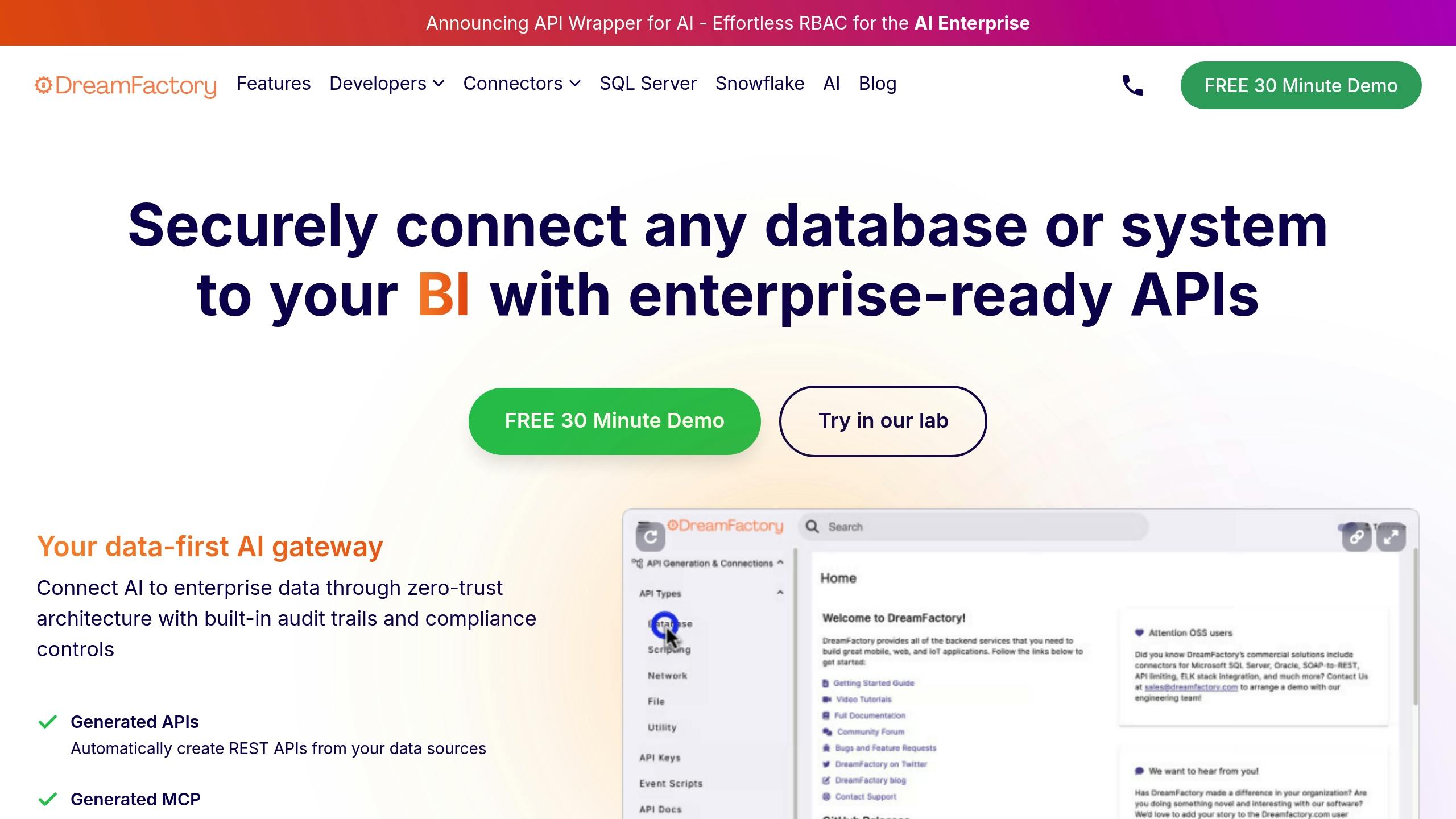Managing data across hybrid systems while meeting regulatory requirements is a growing challenge for businesses. Here's what you need to know:
-Hybrid Data Integration connects on-premises and cloud systems, offering flexibility for businesses managing sensitive workloads.
-Regulatory Compliance ensures businesses follow laws governing data storage, processing, and security. Non-compliance risks include fines, legal issues, and reputational damage.
-Key Challenges in hybrid environments include data security, interoperability, and meeting global regulations like GDPR, HIPAA, and CCPA.
Best Practices include:
- Automating compliance with tools for data classification, encryption, and access control.
- Implementing continuous monitoring and centralized logging.
- Ensuring data residency and sovereignty through audits and agreements with cloud providers.
- Using API management platforms to enforce compliance policies.
Conclusion: Businesses must integrate compliance into their hybrid strategies with strong governance, automation, and security measures to avoid risks and maintain trust.
Hybrid Cloud Day 2022: Data residency fundamentals
Overview of Major Regulations
Organizations operating in hybrid environments face a complex web of regulations, with requirements varying by jurisdiction. Navigating these rules is critical for avoiding penalties and maintaining smooth operations.
The regulatory landscape includes both international frameworks and U.S. laws governing data handling across cloud and on-premises systems. For example, the General Data Protection Regulation (GDPR) enforces strict controls on how data belonging to EU citizens is managed. In the U.S., laws like the California Consumer Privacy Act (CCPA) and its successor, the California Privacy Rights Act (CPRA), protect California residents, with penalties reaching up to $7,500 per willful violation and $2,500 for inadvertent ones.
Industry-specific regulations add another layer of complexity. Healthcare providers must comply with HIPAA, financial institutions are subject to SOX and FINRA, payment processors need to meet PCI DSS, and government contractors must adhere to FedRAMP and FISMA standards. Meanwhile, new regulations, such as the EU Digital Operational Resilience Act (DORA), U.S. SEC Cybersecurity Rules, and the UK's Data Protection and Digital Information Bill, are introducing stricter requirements for incident response, breach notifications, and supply chain security. A notable example is a European financial firm that faced fines for processing customer data in non-compliant regions.
Cross-border compliance presents additional challenges. Laws like China’s Cybersecurity Law and the U.S. CLOUD Act, along with data residency requirements, create a patchwork of rules. According to McKinsey, 75% of countries now enforce some form of data residency law, making geographic considerations a key factor in designing hybrid systems.
These varied regulations highlight the need for strong technical controls, which are explored in the next section.
Core Compliance Requirements
Ensuring compliance in hybrid environments requires a combination of technical and operational measures.
A strong starting point is data classification and discovery. Automated tools can scan and categorize data to identify which regulations apply, such as GDPR or HIPAA. As Ari Weil from Akamai explains:
"They can quickly scan and categorize data to identify what's subject to specific laws, such as GDPR or HIPAA, and identify where to apply or enforce policies accordingly. This not only speeds up compliance but also reduces human error."
Consistent security controls are equally important. End-to-end encryption protects data both in transit and at rest, while role-based access control (RBAC) ensures users only access data relevant to their responsibilities. In hybrid systems, securing APIs and integration points with proper authentication and authorization mechanisms is critical.
To maintain visibility, organizations should implement continuous monitoring, auditing, and centralized logging. These tools help identify and close potential gaps before they result in violations. For example, under New York's SHIELD Act, fines range from $500 to $3,000 per violation, making proactive monitoring essential.
A tailored incident response plan is another must-have, particularly as breach notification requirements become stricter. Finally, a balanced governance framework is key. Nick Elsberry from Xebia highlights the importance of a centralized team that:
"gathers requirements from decentralized teams, sets policies and guidelines, purchases and provides data management tools, and educates and coaches decentralized teams."
Once these controls are in place, understanding where data resides becomes the next critical step.
Data Sovereignty and Residency
Knowing where data is stored and processed is increasingly important as governments assert control over data generated within their borders. Terms like data sovereignty, residency, and localization carry distinct compliance implications:
|
Concept |
Definition |
Key Compliance Implications |
|---|---|---|
|
Data Sovereignty |
Government authority over data within its borders |
Impacts cross-border data transfers and international agreements |
|
Data Residency |
Physical location of stored data |
Influences infrastructure design and vendor selection |
|
Data Localization |
Requirement to store/process data within specific regions |
May require local data centers and higher operational costs |
With nearly half of organizations’ production workloads now running in public clouds, regular data audits are essential to determine where data is stored and which rules apply. Hybrid cloud models offer a practical solution by combining local data storage with cloud services that meet residency requirements.
To navigate these complexities, organizations must collaborate with cloud providers that hold the necessary compliance certifications and offer clear contractual protections. Data processing agreements should specify storage locations and conditions for data access by foreign governments. Effective risk management strategies should include strong data governance, robust encryption, and continuous monitoring of evolving data protection laws . As Deputy Attorney General Todd Blanche points out:
"If you're a foreign adversary, why would you go through the trouble of complicated cyber intrusions and theft to get Americans' data when you can just buy it on the open market or force a company under your jurisdiction to give you access?"
Best Practices for Achieving Compliance in Hybrid Data Integration
Navigating the challenges of data sovereignty and residency requires a strategic approach. These best practices help ensure regulatory compliance while unlocking the potential of hybrid data integration.
Planning and Risk Assessment
A solid foundation for any compliant hybrid integration project starts with detailed planning and a thorough risk assessment. This process involves identifying the sensitive data your organization handles and evaluating potential security risks tied to integration efforts. By identifying vulnerabilities early, you can address them proactively.
Key steps include classifying data assets, reviewing existing security policies, comparing on-premises and cloud workloads, and conducting a comprehensive risk assessment. It's essential to define security and compliance needs upfront - this includes determining data sensitivity levels, setting up access controls, specifying encryption standards, and aligning with relevant regulatory frameworks.
Many organizations have successfully adopted this approach. For instance, financial institutions have achieved PCI-DSS compliance, while healthcare networks have met HIPAA requirements through meticulous planning. These efforts often involve zero trust models, secure APIs, and automated compliance monitoring.
Once risks are assessed, the next step is implementing strong security measures.
Implementing Security Controls
Effective security measures are built on the groundwork of careful planning. In hybrid environments, robust security controls are critical for maintaining compliance. One key method is role-based access control (RBAC), which limits access by assigning permissions based on user roles, ensuring only authorized personnel can access specific resources.
Another cornerstone is data encryption, which must be applied both at rest and in transit. Tools like AWS Key Management Service (KMS), Azure encryption services, and Transport Layer Security (TLS) are widely used to safeguard data.
Organizations should also enforce Identity and Access Management (IAM) policies that follow the principle of least privilege and incorporate multi-factor authentication (MFA). Deploying Data Loss Prevention (DLP) solutions further helps monitor and protect sensitive information from unauthorized access or leaks.
A practical example from the healthcare sector highlights how RBAC can be customized. Nurses, for instance, might have permissions to view patient data and record vitals, while doctors could have full read/write access to patient records and prescription capabilities. Meanwhile, admission clerks might only handle patient registration and appointment scheduling.
Automation plays a vital role here, ensuring consistent enforcement of policies and enabling rapid responses to potential threats.
Continuous Monitoring and Auditing
Maintaining compliance in hybrid environments requires ongoing monitoring and auditing. Continuous monitoring helps detect violations in real time, bolsters security, and reduces the risk of legal penalties.
Automated compliance tracking systems provide real-time insights, making it easier to adapt to changing regulations. Advanced tools now incorporate blockchain for immutable audit records, adding transparency and accountability. Artificial intelligence and machine learning further enhance these systems, enabling them to predict risks and issue alerts before problems arise.
For example, a multinational bank implemented an AI-driven monitoring platform integrated with blockchain-backed audit trails. This system automated threat detection and remediation, reducing vulnerabilities while offering regulators real-time compliance updates. Similarly, a global retailer using a hybrid IT model benefited from automated monitoring that identified transaction anomalies, reduced fraud, and ensured adherence to international regulations.
To strengthen compliance efforts, organizations should regularly reassess risks, provide employee training to prevent accidental violations, and maintain detailed documentation and audit trails. These practices simplify audits and help avoid penalties.
Role of API Management and Integration Platforms in Compliance
API management platforms play a pivotal role in helping organizations navigate the intricate world of regulatory compliance, especially in hybrid data integration scenarios. They serve as a crucial link between various systems while ensuring that security and governance standards align with modern regulatory requirements. This builds on earlier discussions about the importance of continuous monitoring and data security, extending those principles to the realm of API management.
Simplifying Compliance with API Management
Today’s API management platforms are designed to automate key compliance-related tasks, such as security enforcement, documentation creation, and audit trail generation. By eliminating manual coding - often a source of vulnerabilities - these platforms maintain consistent data structures and allow for customized compliance logic through server-side scripting.
These automated capabilities enable platforms like DreamFactory to tackle complex compliance requirements head-on.
How DreamFactory Supports Compliance

DreamFactory’s architecture is tailored to address the compliance challenges organizations face. The platform incorporates a robust security policy framework based on the Cloud Security Alliance's Consensus Assessments Initiative Questionnaire (CAIQ v3.0.1), aligning with major standards like SOC, COBIT, FedRAMP, HITECH, ISO, and NIST.
"Customer privacy is a paramount concern for DreamFactory. This focus goes to the heart of our product which allows customers to retain full control of their data, as well as rapidly create and manage personalized controls."
DreamFactory also aligns with key privacy regulations, including GDPR, PIPEDA, COPPA, HIPAA, and FERPA. Its defense-in-depth strategy ensures secure data access through individually generated API keys. Additionally, the platform supports LDAP, Active Directory, and SAML-based single sign-on (SSO), enabling seamless integration with existing identity management systems. With over 20 connectors - such as Snowflake, SQL Server, and MongoDB - and deployment options across Kubernetes, Docker, or Linux environments, DreamFactory helps organizations meet data sovereignty requirements. Administrators can fine-tune compliance settings by customizing rate limits, logging, reporting, and defining granular API key permissions. They can also map AD/LDAP groups to specific roles.
Real-Time Monitoring and Documentation
In hybrid environments, real-time monitoring is essential. Non-compliance can cost businesses an average of $14.82 million annually, with more than 60% of compliance failures stemming from delayed monitoring and manual processes.
DreamFactory addresses this by offering real-time traffic auditing through integrations with tools like Elasticsearch, Logstash, and Kibana or Grafana dashboards. Automated logging generates detailed audit trails - without default data storage - and provides instant insights into system health. This enables proactive risk detection, mitigation, and compliance reporting.
As the global datasphere is projected to reach 393.9 zettabytes by 2028, the importance of real-time data integration cannot be overstated. DreamFactory’s approach ensures users can extract actionable insights almost instantly - typically within milliseconds - while maintaining compliance with regulatory standards. This real-time, automated documentation not only enhances transparency but also ensures continuous adherence to regulations in hybrid environments.
Compliance Challenges and Mitigation Strategies in Hybrid Data Integration
Navigating compliance in hybrid data integration environments can be daunting. These systems, which combine on-premises infrastructure with multiple cloud platforms, introduce layers of complexity that traditional setups simply don’t face.
Common Compliance Challenges
Compliance in hybrid environments comes with its own set of hurdles:
Asset Visibility and Shadow IT: Hybrid systems often lead to a lack of oversight, with new resources and integrations popping up without proper approval. Departments might even use unapproved cloud services, creating gaps in compliance.
Data Sovereignty and Residency: Managing data across multiple jurisdictions can lead to serious compliance risks. Non-compliance with local regulations can result in hefty penalties.
Industry-Specific Regulations: Frameworks like HIPAA, PCI DSS, SOX, FINRA, FedRAMP, and FISMA all come with their own requirements. Hybrid environments make it tough to meet these overlapping standards simultaneously.
Data Quality and Governance: Poor data governance undermines compliance from the start. Without clear roles and ownership, governance frameworks weaken. As Thomas Redman says:
"No matter how advanced and sophisticated a machine learning model is, its effectiveness and accuracy are highly dependent on the quality of input information."
Cultural Resistance: Teams working in silos often resist new governance measures, which can result in blind spots in compliance monitoring.
Addressing these challenges is critical to ensuring compliance in hybrid data setups.
Effective Mitigation Strategies
Organizations can tackle these issues with targeted strategies:
Continuous Monitoring and Automation: Real-time monitoring and automation are vital for catching compliance violations early. The 2017 Equifax breach, which exposed sensitive data of over 140 million people and cost more than $700 million, highlights the consequences of inadequate compliance measures.
Centralized Compliance Dashboards: These dashboards consolidate visibility across systems, offering real-time insights into configurations, access logs, and user activity.
Automated Controls: Automated systems track compliance continuously, flagging risks, categorizing them by severity, and escalating critical issues for quick resolution.
Data Residency Strategies: Conducting data audits and using cloud providers with specific residency options ensures data stays within required jurisdictions. Clear policies for data classification, access control, and lifecycle management are also essential .
Third-Party Audits: Regular audits by external experts validate compliance efforts and prepare organizations for both internal and external reviews. Comprehensive documentation ensures readiness for audits tied to regulations like HIPAA, GDPR, and SOX .
By combining automation, centralized tools, and rigorous audits, organizations can strengthen their compliance frameworks.
Comparing Compliance Approaches
The choice between manual and automated compliance methods directly affects efficiency and cost:
|
Approach |
Manual Monitoring |
Automated Monitoring |
|---|---|---|
|
Detection Speed |
Days to weeks |
Real-time alerts |
|
Resource Needs |
High staff involvement |
Low - automated systems |
|
Accuracy |
Prone to human error |
Consistent and reliable |
|
Scalability |
Limited by workforce |
Scales automatically |
|
Cost Impact |
High labor costs |
Lower operational costs |
|
Audit Readiness |
Manual documentation |
Automated audit trails |
Similarly, the choice between on-premises and cloud-based controls impacts flexibility and oversight:
|
Control Type |
On-Premises Controls |
Cloud-Based Controls |
|---|---|---|
|
Data Sovereignty |
Full control over data |
Dependent on provider |
|
Customization |
Complete flexibility |
Limited by provider |
|
Compliance Visibility |
Direct system access |
Requires API integration |
|
Maintenance Overhead |
High |
Lower - provider-managed |
|
Disaster Recovery |
Separate infrastructure |
Built-in redundancy |
These comparisons highlight the benefits of automated, cloud-based solutions in simplifying compliance.
Looking ahead, the trend toward automation and information unification is clear. By 2025, organizations adopting unified data strategies are expected to see a 30% boost in decision-making speed and a 25% improvement in overall performance. Additionally, the number of organizations with governance frameworks is projected to rise from 60% in 2023 to 71% in 2025.
Taking a "compliance first" approach to cybersecurity and integrating regulatory requirements into hybrid data strategies is no longer optional - it’s a necessity. With the right tools and governance in place, businesses can navigate regulatory landscapes while staying efficient and secure.
Conclusion: Ensuring Regulatory Compliance in Hybrid Data Integration
Regulatory compliance in hybrid data integration goes beyond ticking boxes; it requires careful planning, solid execution, and the right technological tools. The complexity of compliance increases in hybrid architectures, making it a challenge that demands attention.
The journey to compliance starts with detailed planning and risk assessment. This process helps identify requirements, uncover gaps, and align security measures with the organization’s goals.
Automation plays a critical role in managing compliance effectively. Relying on manual processes simply doesn’t cut it in the fast-moving landscape of hybrid environments. Automated systems provide real-time asset discovery and alerts, which are crucial for staying ahead in these dynamic settings. These tools work hand-in-hand with strong API management strategies, creating a seamless approach to compliance.
API management platforms are a cornerstone of this effort. With projections showing that over 70% of businesses will depend on APIs for integration by 2025, platforms like DreamFactory offer built-in security features - such as RBAC, API key management, and OAuth integration - that help ensure compliance in hybrid setups.
Beyond automation and secure APIs, data governance is the backbone of any compliance strategy. As Shivbhadrasinh Gohil, Co-founder & Chief Marketing Officer, explains:
"Grasping information relationships is vital for successful unification, as they constitute the foundation of efficient system communication."
This insight becomes even more relevant as global data volumes are projected to grow by 250% by 2025, making strong data governance frameworks indispensable for scaling compliance efforts.
Organizations that prioritize compliance reap significant rewards. A well-executed compliance strategy leads to faster decision-making, reduced costs, and increased trust from stakeholders.
Adopting a "compliance-first" mindset means weaving regulatory requirements into every layer of a data strategy. This involves implementing robust encryption for data in transit and at rest, enforcing strict access controls based on the principle of least privilege, and maintaining comprehensive logging and monitoring across all systems.
FAQs
What challenges do businesses face in maintaining regulatory compliance in hybrid data integration projects?
Managing regulatory compliance in hybrid data integration projects can be a tricky process, largely because of the diverse challenges involved. A key issue is data sovereignty - when data moves across borders, it must comply with the laws and regulations of each region, which can vary significantly.
Another hurdle is maintaining consistent security measures across the various systems and platforms that make up a hybrid environment. The complexity of these setups often makes it harder to ensure uniform protection.
On top of that, adhering to industry-specific regulations like HIPAA or PCI DSS becomes more complicated when workloads are spread across different platforms. Organizations also face the challenge of implementing strong data governance practices and gaining complete visibility into all assets within their hybrid ecosystems. Both are essential for staying compliant in such environments.
How can organizations streamline compliance in hybrid data systems to minimize risks and protect sensitive data?
To simplify compliance in hybrid data systems, organizations can turn to automation tools. These tools help enforce regulatory standards, cut down on manual processes, and reduce the chance of human error. By continuously monitoring system activity, they can flag potential issues and ensure compliance is maintained.
A few effective strategies include using role-based access controls (RBAC) to limit access based on user roles, integrating encryption protocols to protect sensitive information, and automating policy enforcement across hybrid environments. Focusing on these tactics strengthens data security, mitigates risks, and supports strong governance in the intricate landscape of hybrid systems.
How do API management platforms help ensure regulatory compliance in hybrid data integration?
API management platforms play a crucial role in maintaining regulatory compliance within hybrid data integration. They provide powerful tools for security, governance, and monitoring, helping organizations meet data privacy requirements like GDPR. With features such as authentication, authorization, and role-based access control (RBAC), these platforms ensure that sensitive information stays protected and is only accessible to authorized users.
Beyond security, these platforms support policy enforcement, generate detailed audit trails, and offer real-time analytics to track API usage. This combination not only helps businesses demonstrate compliance but also reduces risks and promotes transparency in their data integration workflows. By automating and simplifying these processes, API management platforms make it easier to navigate the legal and regulatory challenges of hybrid environments.
Kevin McGahey is an accomplished solutions engineer and product lead with expertise in API generation, microservices, and legacy system modernization, as demonstrated by his successful track record of facilitating the modernization of legacy databases for numerous public sector organizations.
























 Blog
Blog



